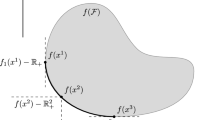Abstract
The efficiency of local search is proportional to the number and the distribution of basins of attraction. Often combinatorial optimisation problems have a large number of local optima, uncountable with available computational resources. Approximating the number of basins of attraction and the minimal number of samples for visiting all basins at least once are complex problems for which we assume specific distributions of basins of attraction. We define two types of basins of attraction of multi-objective combinatorial optimisation problems with complementary properties. Acknowledging that each local search run generates a Pareto front of solutions, either each Pareto local solution corresponds to a basin of attraction, or a Pareto basin matches an entire Pareto local front. Simulations compare parametric and non-parametric estimators on bi-objective quadratic assignment problem instances.





Similar content being viewed by others
References
Alyahya K, Rowe JE (2016) Simple random sampling estimation of the number of local optima. In: International conference on parallel problem solving from nature (PPSN). Springer, New York, pp 932–941
Bilodeau M, Brenner D (2008) Theory of multivariate statistics. Springer, New York
Burnham KP, Overton WS (1978) Estimation of the size of a closed population when capture probabilities vary among animals. Biometrika 65(3):625–633
Buzas J, Dinitz J (2014) An analysis of NK landscapes: interaction structure, statistical properties, and expected number of local optima. IEEE Trans Evolut Comput 18(6):807–818
Drezner Z, Hahn PM, Taillard ÉD (2005) Recent advances for the quadratic assignment problem with special emphasis on instances that are difficult for meta-heuristic methods. Ann Oper Res 139(1):65–94
Durrett R (2013) Probability: theory and examples. Cambridge University Press, Cambridge
Ehrgott M (2005) Multicriteria optimization. Springer, New York
Elorza A, Hernando L, Mendiburu A, Lozano JA (2018) Estimating attraction basin sizes of combinatorial optimization problems. In: Progress in artificial intelligence
Eremeev A, Reeves CR (2002) Non-parametric estimation of properties of combinatorial landscapes. In: Applications of evolutionary computing. Springer, Berlin, pp 31–40
Feller W (1950) An introduction to probability theory and its applications. Wiley, Hoboken
Garnier J, Kallel L (2001) Efficiency of local search with multiple local optima. SIAM J Discrete Math 15(1):122–141
Goldman BW, Punch WF (2016) Hyperplane elimination for quickly enumerating local optima. In: Evolutionary computation in combinatorial optimization EvoCOP, pp 154–169
Happel R, Stadler PF (1996) Canonical approximation of fitness landscapes. Complexity 2(1):53–58
Hernando L, Mendiburu A, Lozano JA (2013) An evaluation of methods for estimating the number of local optima in combinatorial optimization problems. Evolut Comput 21(4):625–658
Knowles JD, Corne DW (2000) Approximating the nondominated front using the Pareto archived evolution strategy. Evolut Comput 8(2):149–172
Kollo T, von Rosen D (2005) Advanced multivariate statistics with matrices. Springer, New York
Liu C, Rubin DB (1995) ML estimation of the multivariate t-distribution with unknown degrees of freedom. Stat Sin 5:19–39
Ochoa G, Tomassini M, Vérel S, Darabos C (2008) A study of NK landscapes’ basins and local optima networks. In: Proceedings of the conference on genetic and evolutionary computation (GECCO), ACM, pp 555–562
Paquete L, Stützle T (2006) A study of stochastic local search algorithms for the biobjective QAP with correlated flow matrices. Eur J Oper Res 169(3):943–959
Prügel-Bennett A, Tayarani-Najaran M-H (2012) Maximum satisfiability: anatomy of the fitness landscape for a hard combinatorial optimization problem. IEEE Trans Evolut Comput 16(3):319–338
Reeves CR, Eremeev AV (2004) Statistical analysis of local search landscapes. JORS 55(7):687–693
Reidys CM, Stadler PF (2002) Combinatorial landscapes. SIAM Rev 44(1):3–54
Srinivas N, Deb K (1994) Multiobjective optimization using nondominated sorting in genetic algorithms. Evolut Comput 2(3):221–248
Verel S, Ochoa G, Tomassini M (2011) Local optima networks of NK landscapes with neutrality. IEEE Trans Evolut Comput 15(6):783–797
Wishart J (1928) The generalised product moment distribution in samples from a normal multivariate population. Biometrika 20A(1–2):32–52
Author information
Authors and Affiliations
Corresponding author
Rights and permissions
About this article
Cite this article
Drugan, M.M. Estimating the number of basins of attraction of multi-objective combinatorial problems. J Comb Optim 37, 1367–1407 (2019). https://doi.org/10.1007/s10878-018-0357-8
Published:
Issue Date:
DOI: https://doi.org/10.1007/s10878-018-0357-8




